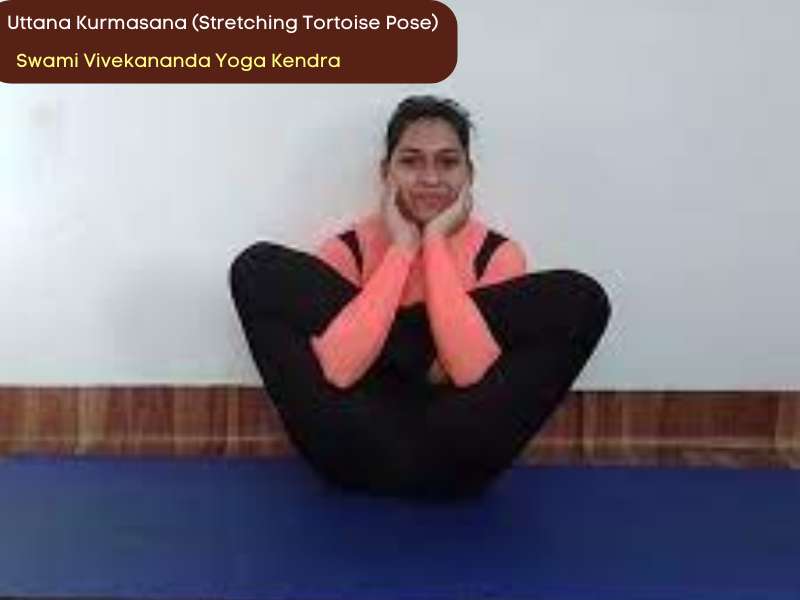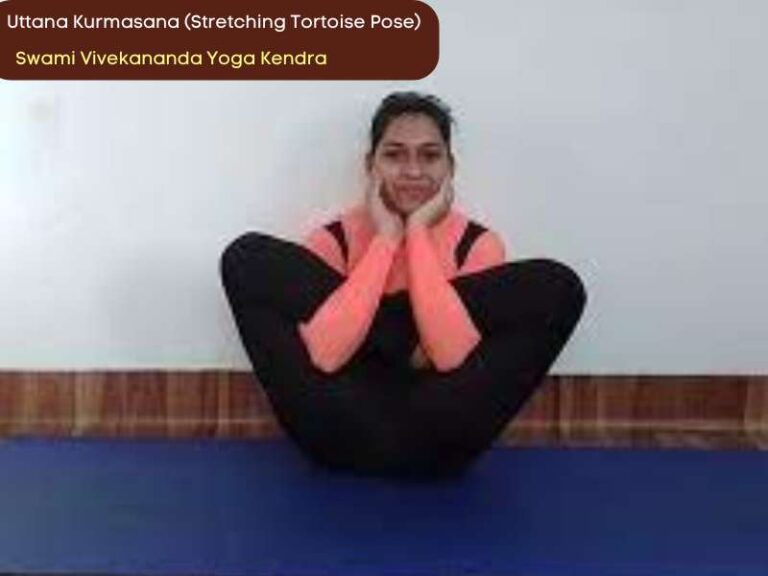There are yoga poses that energize you, and then there are poses that take you inward—like Uttana Kurmasana, or the Stretching Tortoise Pose. This pose feels like a full-body sigh of relief. It challenges your body while calming your mind, inviting you to slow down and truly connect with yourself.
If you’ve already tried Kurmasana (Tortoise Pose), Uttana Kurmasana takes that same inner stillness a step deeper—with a stretch that’s both physical and emotional.
🧘♀️ How to Practice Uttana Kurmasana (Stretching Tortoise Pose)

This pose is a bit more advanced than it looks, so take your time and listen to your body. Here’s a friendly step-by-step guide to help you ease into it:
1. Sit Tall to Begin
Start seated on your mat, legs extended straight out in front of you (like in Staff Pose or Dandasana). Sit up nice and tall, feel the length in your spine, and take a few grounding breaths.
2. Open Your Legs Slightly
Gently spread your legs apart into a wide V shape. Not too wide—just enough to give your torso room to fold forward. Keep your knees and toes pointing upward.
3. Slide Your Arms Under Your Legs
Now slowly lean forward and reach each arm under your thighs. Your arms will slide out to the sides under your legs, palms facing the floor. Let this feel natural and unforced.
4. Lower Your Chest and Head
Continue folding forward until your chest and chin get closer to the floor, in between your legs. Try to relax your upper body and let gravity help you go deeper.
5. Lift Your Legs Gently
Here’s the challenging part: once you’re settled in the pose, gently lift both legs just an inch or two off the floor, balancing on your sit bones and pressing the legs into your arms. Keep breathing!
6. Hold and Breathe
Stay in the pose for 20–30 seconds (or more, if you feel comfortable). Let your breath be smooth and steady. If anything feels painful, come out of the pose slowly.
7. Release with Care
To exit, slowly lower your legs, slide your arms out, and return to a seated position. Move gently and thank your body for its effort.
🌿 Why You’ll Love Uttana Kurmasana: Real Benefits Explained
Uttana Kurmasana isn’t just a fancy-looking pose—it offers deep healing and powerful rewards, especially if you practice regularly and with awareness.
✨ 1. Gives a Deep Stretch
This pose is a total stretch for your hips, legs, back, and shoulders. If you’re tight from sitting too much or working at a desk, this pose helps release all that tension.
✨ 2. Builds Body Awareness
Balancing in this position helps you tune into how your body moves and feels. It’s a great way to improve your coordination and alignment.
✨ 3. Strengthens the Core
Lifting your legs while keeping your arms extended activates your abdominal muscles. Over time, it strengthens your belly and inner thighs.
✨ 4. Calms the Nervous System
Like most forward bends, this pose naturally soothes the mind. It’s perfect when you feel anxious, overwhelmed, or overstimulated.
✨ 5. Increases Patience & Mindfulness
This isn’t a “quick win” pose. It requires gentleness and time. Practicing Uttana Kurmasana teaches you to breathe through discomfort, stay present, and surrender control.
✨ 6. Enhances Focus and Inner Connection
Because you’re withdrawing your senses and folding inward, this pose creates a meditative experience. It’s not just about the stretch—it’s about the stillness within.
✨ 7. Boosts Energy Flow (Prana)
This pose encourages healthy movement of Apana Vayu, the downward-moving energy. It supports digestion, elimination, and grounding.
🙌 Want to Experience This in Real Life?
At Swami Vivekananda Yoga Kendra, we love helping students explore deeper poses like Uttana Kurmasana in a supportive, safe, and joyful environment. You don’t need to be flexible to begin—just curious.
👉 Join a class or drop in for a session with our experienced instructors. You’ll learn the pose step-by-step and leave feeling centered and inspired.
1. Is this pose only for advanced practitioners?
It is considered an advanced posture, yes—but you can work toward it gradually. We always recommend learning under guidance so your body stays safe and supported.
2. What’s the difference between Kurmasana and Uttana Kurmasana?
Kurmasana involves folding forward and resting on the floor, while Uttana Kurmasana adds an extra challenge by lifting the legs off the ground, creating a more intense stretch and core engagement.
3. What if my hamstrings are really tight?
No problem at all! You can bend your knees slightly or use props like yoga blocks or cushions under your thighs. It’s more important to feel at ease than to force a pose.
4. Can this pose help with mental stress?
Absolutely. Because it encourages you to turn inward, Uttana Kurmasana naturally calms the mind, slows your thoughts, and reduces stress. Think of it like a yoga hug for your nervous system.
💬 Final Thoughts: Let the Pose Teach You
Uttana Kurmasana may look physically intense, but the real magic lies in what it teaches you—patience, humility, stillness, and the joy of simply being present. You don’t need to get it “perfect” to feel the benefits. Even practicing a gentler version can be deeply nourishing.
In yoga (and in life), sometimes the deepest growth happens when we stop striving—and start surrendering.
Transform Your Life with us: Join Our Online Classes Now:
Ready to dive into a world of wellness? Come join us for some online meditation classes to find your inner calm, hop into our online yoga classes to take your practice up a notch, or why not even become a certified yoga teacher? Embrace the power of yoga today and let it lead you to a happier, healthier you!



Comments are closed.